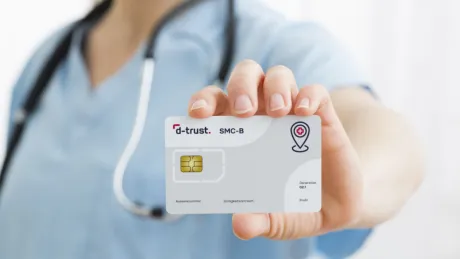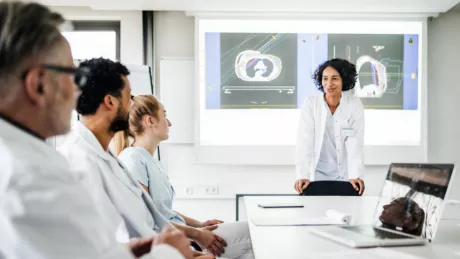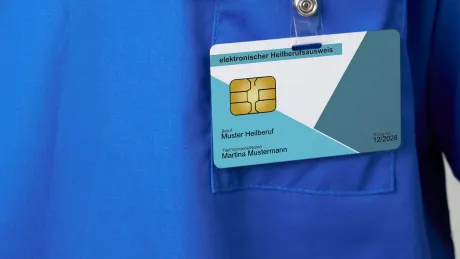TI 2.0: a look into the future
published on 21.04.2022
The telematics infrastructure enables the networking and digitalisation of Germany’s healthcare system. But it’s already time to take the next step: with the help of digital identities, the TI could soon be even faster, more flexible and fit for remote use. A practical use case demonstrates how TI 2.0 makes day-to-day processes easier for doctors and insured persons, and shows the new treatment methods that it makes possible.
Digital identities as the basis for TI 2.0
The telematics infrastructure (TI) is the key to digitalising the healthcare system. All of the relevant stakeholders can connect with each other digitally through it and make use of applications such as the electronic patient file (ePA) and e-prescriptions. Until now, the authentication of doctors, pharmacists and psychotherapists in the digital healthcare network has required special hardware: participating healthcare institutions use the electronic ID card for medical practices and institutions (SMC-B) to authenticate themselves as medical facilities in order to access TI services. The electronic health professional card (eHBA) is a personalised chip card that healthcare professionals use to identify themselves in the telematics infrastructure. And although the TI is already setting new standards for digital healthcare, work is now being done to develop it further: From 2024, under the so-called telematics infrastructure 2.0, service providers should also be able to use digital identities, in addition to the haptic cards. Among other aspects, this could allow doctors to use their smartphones to connect to the telematics infrastructure using virtual authentication. The current situation is that the legal introduction of digital identities for insured persons is scheduled for 2023. An example of an application illustrates the tangible benefits that TI 2.0 can bring for physicians and patients.
Video consultations via smartphone
Telematics infrastructure 2.0 opens up new possibilities for location-independent communication between doctors and their patients. This is different to eHBA and the like, which have so far been tied to a permanent workplace such as a practice or clinic. However, if authentication is done virtually and without needing a card via the telematics infrastructure (TI), then activities such as video consultations – including the issuing of e-prescriptions – could also take place easily within the TI using a smartphone and without requiring additional hardware. In the future, a treatment consultation could then take the following form, for example: The doctor sits down at their workstation and picks up the smartphone. The doctor uses their digital identity to log into a special app for the video consultation, regardless of whether they are at a practice, in private offices or abroad. This digital identity is stored in a so-called wallet, which is also installed as an app on the doctor’s smartphone. Using the wallet, the doctor authenticates their identity as a service provider to the video consultation provider. If that all works, the app for the upcoming video consultation opens. The video consultation can begin as soon as the patient is present.
The insured person and the consulting doctor now see and greet each other using the smartphone camera. The patient explains their concerns and describes their state of health to the doctor. This particular case is about follow-up treatment in the comfort of the patient’s own home after a hospital stay. Laboratory results and the patient's medication schedule are available in the document area of the app during the video consultation. Other relevant information, such as the insured person's status, is also available there. Using the data in the app and the personal consultation, the doctor concludes that: the patient needs different medication, as the drug that has already been prescribed is not having the desired effect. Therefore, at the end of the telemedical consultation, the doctor decides to issue an e-prescription for the patient. This, too, can be done without any additional hardware. During the video consultation itself, the doctor can use a remote signature to sign the necessary prescription digitally, without using any other hardware. The insured person can access it straight away through the specially designed prescription app and redeem it in the pharmacy. The doctor is sure that the new drug will be more beneficial for the patient. The two exchange parting farewells via the smartphone camera.
TI 2.0 thus enables telemedicine treatments that are neither location-bound nor cause media disruptions. Authenticating the parties involved may take place completely virtually. Doing so requires secure digital identities; these lay the foundations for a successful transition to telematics infrastructure 2.0. Applications that work entirely electronically, such as the remote signature, which is based on the doctor's digital identity, complete the healthcare network of the future.
TI 2.0 enables remote working for doctors
The advantages for doctors of virtual authentication in the telematics infrastructure are quite evident: TI is not only faster and more flexible to use, but it also offers medical professionals the opportunity to work from any location. Whereas many people swapped the office desk for their home office in the course of the coronavirus pandemic, this option was not available to doctors. Even TI couldn't change that reality, given the necessary hardware components. It is expected that connectors, cards and terminals will no longer be required in TI 2.0. For the first time, doctors working in private practice, as well as those in clinics, will have the opportunity to perform telemedical treatments and patient consultations remotely.
However, an important point is that haptic cards such as the electronic health professional card (eHBA) and the associated readers and connectors will not be replaced with virtual versions in the near term. Instead, virtual authentication solutions should serve as a convenient add-on and make remote working easier for doctors interested in that option. These solutions can also serve as a back-up, in the event that haptic cards are lost or damaged. The legal framework for this development is provided by the Digital Supply and Care Modernisation Act (DVPMG). It stipulates that, from 1st January 2024, doctors will be able to obtain a digital identity for use in digital healthcare applications. Particularly for nursing staff, who are only just starting to get connected to the telematics infrastructure, mobile operations seem to be the best way forward in the medium term anyway. The same applies for insured persons themselves: patients want to access their data through the telematics infrastructure and to view and share documents from their electronic patient file, among other aspects. In the age of smartphones, hardware-based solutions are clearly not realistic. Once again, it all comes down to virtualisation.
DMEA 2022: digital identities you can touch
To make the advantages of telematics infrastructure 2.0 even more tangible, D-Trust GmbH is presenting the use case described for digital medical appointments at the “DMEA – Connecting Digital Health” trade fair. This event, which focuses on digital healthcare, will be held in Berlin from 26th April to 28th April 2022. In a lecture on 27th April, Dr. Kim Nguyen, Managing Director of D-Trust GmbH, will discuss additional use cases for secure digital identities and will offer an insight into the development work being performed at D-Trust.







